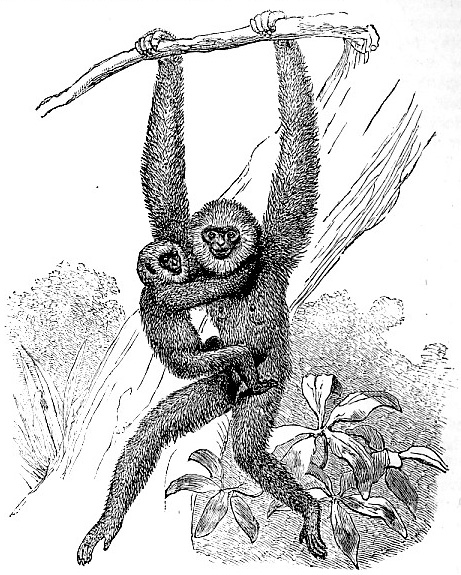1902 Encyclopedia > Ape > Ape: Family I - Simiadae, Sub-Family 1 - Simiinae. Gibbons.
Ape
(Part 5)
<
(B) Apes Classified by Family, Sub-Family and Genera (cont.)
Ape: Family I - Simiadae, Sub-Family 1 - Simiinae. Gibbons.
The gibbons, or long-armed apes, form the genus Hylobates, confined in the present day to the south-eastern continent of Asia and the Indian Archipelago. There are several species, but individual variation and sexual difference in colour are so great that their limits are not yet well defined.

Fig. 4 -- The Entellus-like Gibbon (Hylobates enteloides). From Archives du Museum, vol. ii, pl. 29.
One well-marked species, the largest of the genus, is the siamang (H. syndactylus) of Sumatra, which is remarkable as being the ape with the best developed chin and widest breast-bone. It has also the second and third toes united by skin down to the last joint of each.
Another well-marked form is the hoolock of Assam (H. hoolock). In the gibbons we first find that part upon which he body rests in sitting provided with naked callous spaces, termed (from that part of the haunch bone to which they are applied, the ischium) "ischial callosities;" they are, however, still small.
Though vegetable feeders, the gibbons are probably less exclusively so than are the yet higher apes before noticed. In captivity their manners are gentle, although their activity is surprising; especially remarkable are the enormous distances they can swing themselves by their long arms. In spite of this length of arm, which seems to render their bodily proportions so unlike those of man, the length of leg when compared with the length of the trunk of the body, is more human than in either of the two preceding genera.
Another point in which they approach nearest to man, is the quality of voice which at least some of the species (e.g. H. hoolock) possess.
None of the gibbons have any rudiment of a tail, and they have no cheek pouches, but the canines are elongated and tusk like.
When the body is erect, the arms are so long that they reach the ground. The hallux is well developed, reaching to the middle or end of the proximal phalanx of the index of the foot while the pollex only attains to, or reaches a little beyond, the proximal end of the proximal phalanx of the index of the hand. There is an os intermedium in the carpus.
The laryngeal sacs are no longer prolongations of the laryngeal ventricles, but open into the larynx above the false vocal chords.
The number of species is, as has been said, doubtful, but the following kinds are often reckoned as distinct:-- Syndactylus, Lar, Leuciscus, Agilis, Mulleri, Rafflesii, Hoolock, Entelloides, Pilaetus, and Funereus.
Read the rest of this article:
Ape - Table of Contents
|
